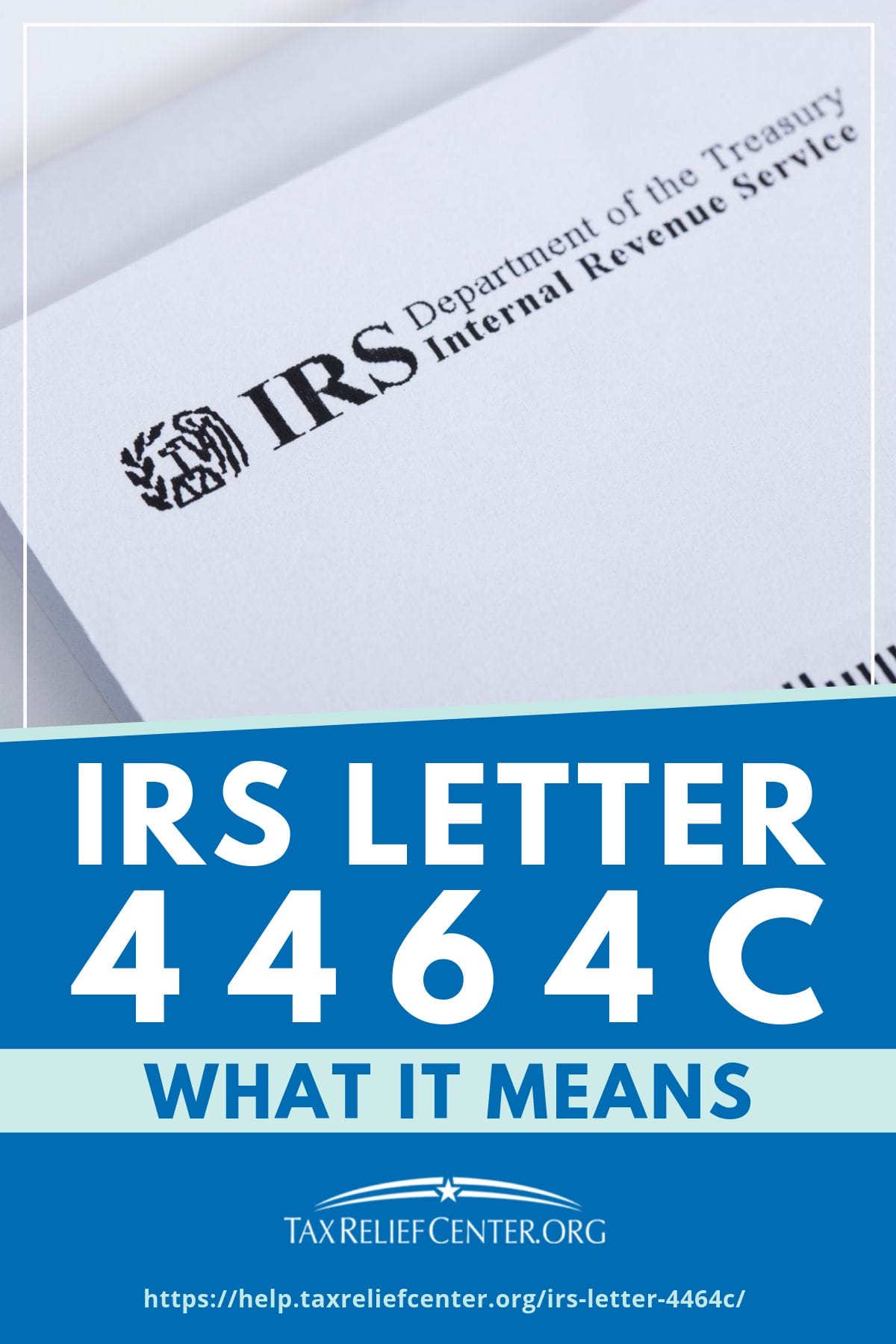Eliminate the fear when receiving an IRS letter 4464C by knowing what it means.
In this article:
- What Is IRS Letter 4464C?
- Why the IRS Sends the Letter
- A Bigger Reason: Identity Theft
- IRS Letter for Verification
- The Contents of the IRS Letter
- What to Do When There’s Identity Theft
- What to Do If a Taxpayer Receives the IRS Letter
- Dealing with Financially Damaging Delays
IRS Letter 4464C | Decoding the Document
What Is IRS Letter 4464C?
A taxpayer has all the right to feel frightened or worried when they receive a notice or any document from the tax man like the IRS Letter 4464C.
If one receives a letter, what is the Internal Revenue Service (IRS) trying to tell them?
Do they owe taxable income, or is it an IRS audit letter? Was there a privacy invasion or identity theft?
The purpose of the IRS Letter 4464C is simple. It mainly informs the recipient two things.
First, the department has received the income tax return. Second, the person cannot expect to receive their tax refund anytime soon because it is still under review.
In most cases, the delay is only 60 days.
Note this letter doesn’t imply a tax audit, which involves much deeper scrutiny of the returns. It is also different from 4883C, which requires the taxpayer to confirm their identity personally.
What Is Tax Review? It is a process wherein the IRS withholds refunds and credits until the taxpayer verifies specific information. These may refer to their personal identity or details on the tax returns.
Why the IRS Sends the Letter
The IRS sends this letter to people due for a refund, but before issuing it, the department wants to verify some of the information.
For instance, if the employees reported a certain amount of income, the IRS can check it against the W-2s it receives from the employer.
In other cases, the IRS might find out certain discrepancies among the tax returns filed over the years. Perhaps there were significant differences in the itemized deductions.
It’s also possible the taxpayer forgot to include information that can make the other data on the returns questionable.
For example, the department received a 1099-INT form from the taxpayer’s bank showing earned interest over the year, and the taxpayer failed to mention it.
A Bigger Reason: Identity Theft
One of the primary reasons for sending IRS letter 4464C is to protect both the agency and the taxpayer from tax identity fraud.
Identity theft is one of the serious types of cybercrimes in the United States. In a 2018 fraud report, over 16 million people became victims of it in 2017, a significant increase compared to the previous year.
Overall, the crime resulted in a loss of a whopping $16.8 billion.
Money, however, isn’t the only repercussion for those who have to deal with losing their identity to someone else. Other possible problems include the following:
1. Issues with the Credit Report and Score—The scammer can use the person’s information to secure a loan or a credit card, which they will not pay. These will then reflect on the owner’s credit report and score.
When the scores decline, the taxpayer may struggle with obtaining a favorable mortgage or loan in the future.
2. Long-Term Financial Ruin—People cannot resolve the situation overnight. Instead, it can take some time even as long as 6 months.
For others, the effect of it can run for years and even lead to filing for bankruptcy, especially if it already involves creditors.
3. Multiple Identity Thefts—Scammers can use a person’s information multiple times for a variety of reasons.
Besides getting a loan, they may utilize it to apply for financial aid or deceive another person for money. They can also use the same to steal the tax refunds and credits.
Tax identity theft is not new and based on the data from the IRS, the numbers are declining.
Note, though, the problem still accounted for thousands of cases.
In 2017, there were over 240,000 reports from the taxpayers. The IRS, meanwhile, confirmed the identity theft of more than 500,000 returns during the same period.
IRS Letter for Verification
A scammer can access a taxpayer’s personal information in many ways. One of these is through phishing emails.
Here’s how it works: The scammer can send a fake email that appears to be legitimate to the user. It will present a supposed problem such as a compromised account.
To resolve the “issue,” the fraudster will then request the recipient to log into a website, where they need to input their username and password. In some cases, they have to provide additional personal data such as birth dates, bank account numbers, and Social Security number.
These are enough for the scammer to submit a tax return in someone else’s name.
They can then file a fake tax return, requesting for a direct deposit of the tax refund into their bank account.
To prevent tax fraud, the IRS started implementing an identity verification process.
It is a complicated system not a lot of people understand. The bottom line is it should help secure the taxpayer’s information.
One of these is IRS letter 4464C. While receiving it doesn’t immediately mean identity theft, it can still be one of the possible explanations for the errors or discrepancies in the tax forms.
RELATED: How To Check Tax Refund Status
The Contents of the IRS Letter
It is usually a one-page letter. The IRS Letter 4464C begins with a statement stating the agency chose the specific tax return for a review.
Then, it outlines the reasons. The IRS review letter may be due to the following:
- Income reported
- Withholding amounts
- Tax credits claimed
- Business income
A taxpayer needs to keep this letter because the information can be useful. If the person does not receive the refund within 60 days, they may have to call the phone number on the letter.
If the person does not have the IRS Letter 4464C anymore, they can call the general customer service number at 1-800-829-1040.
What to Do When There’s Identity Theft
If a taxpayer received the IRS letter but have not yet filed their income tax return, they may already be a victim of identity theft.
To report it, they have to call the IRS immediately at 800-908-4490. The agency needs to know they didn’t file a return.
The person may then have to secure an affidavit called Form 14039 (Identity Theft Affidavit). It requires theft-related information and whether the taxpayer received the 4464C.
The Federal Trade Commission (FTC) and the credit bureaus should also be aware of the fraud. Here’s how to report it to the FTC.
To contact the credit bureaus, use the following information:
- Equifax 800-525-6285
- Experian 888-397-3742
- TransUnion 800-680-7289
A taxpayer can also be more proactive by signing up for identity theft protection. These services monitor all the credit reports and alert them whenever a strange activity takes place.
What to Do If a Taxpayer Receives the IRS Letter
If a taxpayer receives IRS letter 4464C and confirms filing the tax return, they do not have to do anything. They simply need to wait for the tax refund.
In some cases, the IRS may contact the taxpayer or an authorized tax professional for additional information. Simply provide the requested data.
It may also reach out to third parties when necessary. These may include financial institutions, lenders, and employers.
To be on the safe side, a taxpayer should review their tax return for mistakes. If they found one, they must contact the agency immediately.
Taxpayers who contact the IRS must be ready for long wait times. Patience can come in handy.
On average, it takes around 15 minutes at the beginning of the year and approximately 27 minutes from May to December. They can also be longer on Mondays and Tuesdays.
At the beginning of the call, the person needs to provide basic information. These are the Social Security number, name, and most recent address.
They may also have to prepare the information of anyone else on the return such as spouse and dependents.
The agency may also have to ask for the filing status. It can be single, married filing separately, married filing jointly, or head of household.
Supporting documents should be within reach. The IRS agent may ask for information found in these papers for identity verification.
If a taxpayer cannot call the IRS for some reason, they can consider calling the Taxpayer Advocate Service (TAS) at 1-877-777-4778. With an authorization, they can make the call on the taxpayer’s behalf.
Dealing with Financially Damaging Delays
A lot of people rely on their tax refunds. They may be planning to pay the deposit on a new apartment, take a vacation, or pay off bills.
Typically, tax refunds come very quickly. If they opt for a direct deposit, they can sometimes receive it in less than two weeks.
Tax refund delays, though, may still happen for several reasons.
The government shutdown, for example, resulted in the furlough of hundreds of employees. Since it is a tax-filing season, the IRS may focus on tax collection than on refund processing for now.
Either way, these delays can be financially damaging. If the person is suffering from financial stress due to a delayed refund, they can call TAS for assistance.
For those with high tax liability, they can explore other options such as tax relief agreements.
In the end, there are many ways to answer the question “Where’s my refund?” The IRS letter 4464C may explain some of them.
IRS letters like these should not cause any panic unless the taxpayer did something nefarious. If they filed their returns correctly, they can wait for the review to be over.
If they have questions, they can call the IRS or get help from a tax professional. They can help figure out what the letters mean and deal with the department on their client’s behalf.
If the taxpayer ends up owing the IRS money, they can consider tax debt relief.
There are options—there is help available.
Has anyone received a 4464C letter? Share your experiences in the comments section below.
Up Next: How to Get Free Tax Help | Tax Relief Center
Editor’s Note: This article was originally published on June 18, 2018, and has been updated for quality and relevancy.



